Prepositions
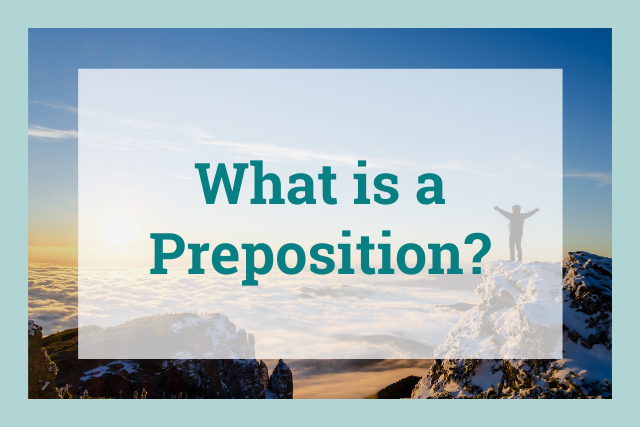
Prepositions are one of the trickiest parts of the English language. We have so many prepositions, and they all have multiple definitions.
Often, prepositions are one of the last parts of a language for people to master. In English, even native speakers struggle with all of our prepositions.
When I’m trying to explain prepositions simply, I like to quote the old nursery song:
“Over the river and through the woods to grandmother’s house we go.”
The bolded words are all examples of prepositions.
But in reality, prepositions are far more complex than giving directions to grandma’s house.
Today we’re diving into a thorough explanation of all things related to prepositions.
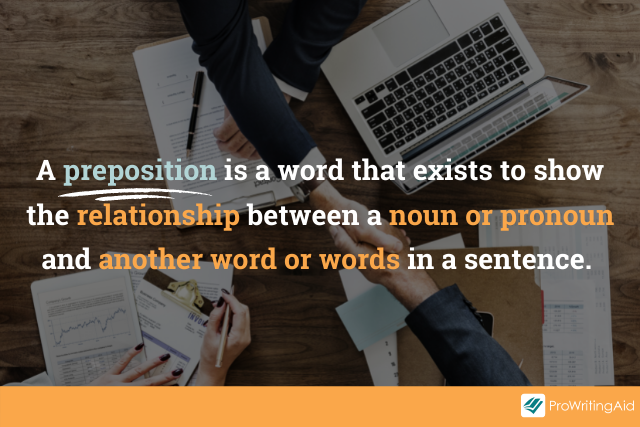
What is a Preposition?
Prepositions are one of the parts of speech, along with nouns, pronouns, verbs, adjectives, adverbs, conjunctions, articles, and interjections.
Prepositions are usually small words, and you’ll find that you use them all the time without even realizing it.
A preposition is a word that exists to show the relationship between a noun or pronoun and another word or words in a sentence.
So, what sort of relationship do prepositions show? There are too many to list. But prepositions are commonly used to show a relationship of time, location, direction, and duration.
Now, let’s get into what some of these important little words look like.
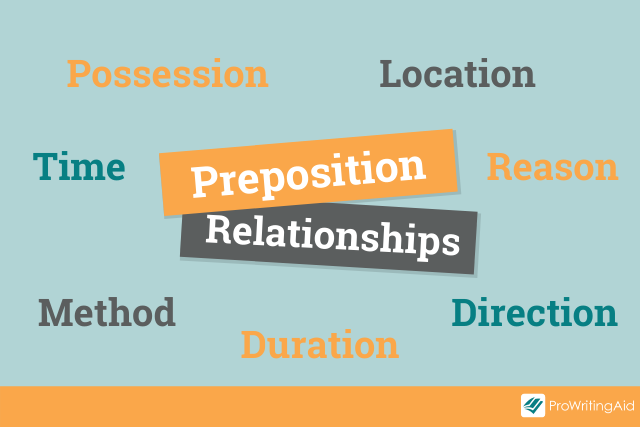
What Are the Most Common Prepositions in English?
There are somewhere around 150 prepositions in the English language! For context, Spanish only has twenty-three, and French has even fewer.
Not only do we have a bunch of prepositions, each one has multiple meanings. No wonder they are so hard to master.
I’m not going to list all 150 prepositions here, but if you are interested in seeing all of them, check out Josef Essberger’s list.
Instead, I’m going to cover several of the most common prepositions. This should give you a good understanding of exactly what a preposition is and how to use it.
To
Possibly the most commonly used preposition, to is a powerful word for having just two letters. Dictionary.com lists a whopping twenty-two definitions.
To often shows direction or motion toward something. It can show a limit, a position, an attachment, a comparison, or a reaction.
To make things even more confusing, to can also replace other prepositions. These are just a few of its uses.
Here are some examples.
- We went to the store.
- Give the phone to your mom.
- I’ll drink to that!
- He took a hit to the face.
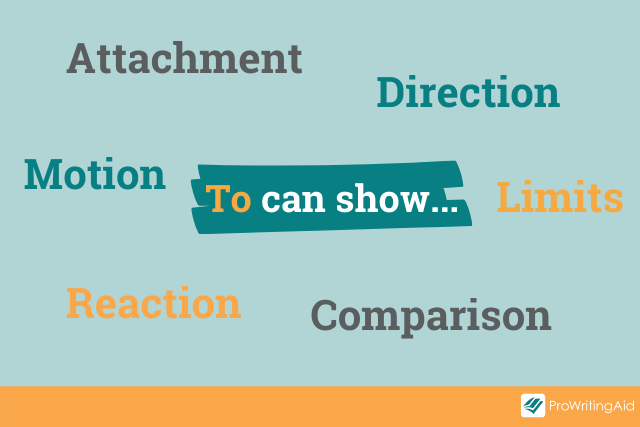
Of
Of is another powerful little word. While we won’t go into all seventeen definitions here, we can talk about a few common uses.
Of can show cause or motive, association, origin, and even direction. It can reference identity or inclusion within a group.
In mathematics, of usually indicates a need to multiply. It can also show what something is made of.
- One of the kids got in trouble today.
- The works of C.S. Lewis are an important contribution to the fantasy genre.
- The entire sculpture was made of butter!
- I live five miles south of the freeway.
For
If you can believe it, for has even more definitions than the previous two prepositions. Dictionary.com lists thirty-two.
Many of these definitions are related to purpose. It can also demonstrate a length of time or distance, a reason or cause, and the extent of something. These are just a few common definitions.
- She works hard for the money.
- I went to the store for ice cream.
- Drive for three miles then turn left.
- We ran for thirty minutes straight.
In
Unlike our last three prepositions, in has fewer definitions, but that doesn’t make it any less common. Usually, in refers to something being within or inside. That can be a location, time, or other limitation.
In can also show purpose or means.
- The dog is in the house.
- We completed the race in two hours.
- This was discussed in the meeting.
- We drank in her honor.
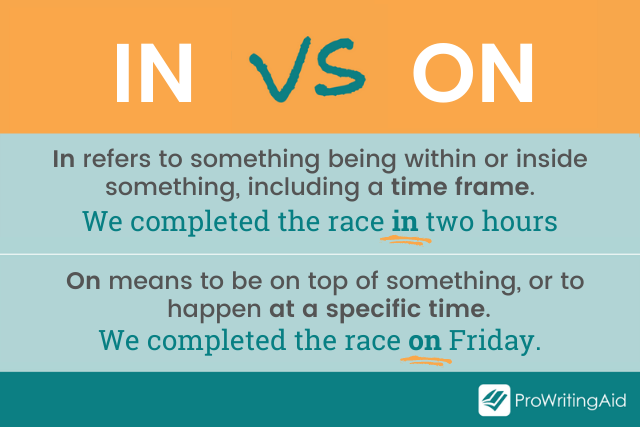
On
On is a preposition that is easy to get mixed up with in. When it refers to a location, it means on top of something.
When on refers to time, it means at a specific time, while in refers to a time frame.
But there are other phrases that are easily confused.
- You saw something on a TV show vs. in a movie
- You read the words on the page vs. in a book
With
The last preposition we’ll cover in greater detail is with.
With has many definitions, but they are more closely related than the various definitions of our other prepositions.
With can mean accompanied by or next. It can show connection or togetherness. It can be used to show comparison and similar opinions. With can also mean to have.
- The team is with you.
(The team supports you.)
- Ben Affleck is back together with Jennifer Lopez.
(Ben Affleck is back in a relationship with Jennifer Lopez.)
- She is a person with great leadership skills.
(She has great leadership skills.)
- Walk with her to the bus stop.
(Accompany her to the bus stop.)
Other Common Prepositions
Let’s take a look at some other common prepositions and use them in sentences.
- I go to bed at 10 p.m. every night.
- Where is he from?
- She told me about her master plan.
- Are you arriving by train?
- Go through the gate on your left.
- He pushed against the wall, but it didn’t budge.
- After my shower, I moisturize my face.
- You cannot use your phone during school hours.
What Are the Four Types of Prepositions?
Not all prepositions are created equal. We can group prepositions into four major categories. These are simple, double, compound, and participle prepositions. Let’s take a look at each in more detail.
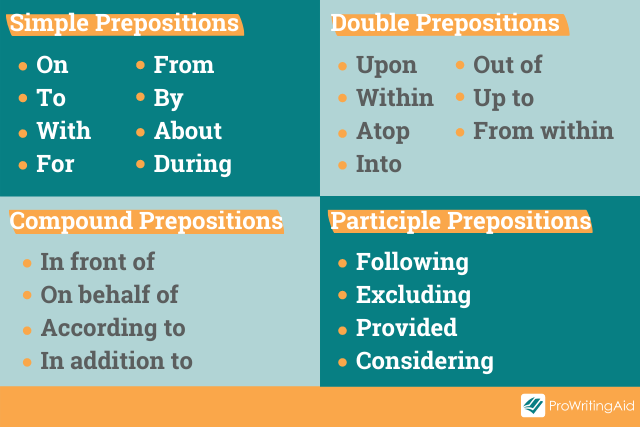
Simple Prepositions
Simple prepositions are what we usually think of when we talk about prepositions. Most of the examples above are simple prepositions. These are just one word, and they are the most commonly used prepositions in English. They include words like on, to, from, by, with, for, about, and during.
Double Prepositions
Like simple prepositions, double prepositions can also be just one word. However, they are made up of two words put together.
They are technically compound words, but don’t confuse them with compound prepositions.
Some examples of one-word double prepositions include upon, within, atop, into. Two-word double prepositions might include out of, up to, from within.
Compound Prepositions
Compound, or complex, prepositions are made up of two or more words. Typically, one of the words is a simple preposition, but the other is not. Examples of compound prepositions include in addition to, according to, in front of, and on behalf of.
Participle Prepositions
Now things get extra tricky. Participle prepositions don’t look like prepositions at all. In fact, they look like verbs!
A participle preposition is when the participle form of a verb—ending in -ed or -ing—functions as a preposition instead of a verb. You can identify these instances by whether or not an object follows the word.
Let’s take a look at some full sentences that use participle prepositions.
- I was surprised she did that, considering her upbringing.
- Following the argument, we did not speak for two days.
- The meeting includes the entire staff, excluding the freelancers.
- He is welcome to join us, provided he brings donuts.
What Are Prepositional Phrases?
Another common grammatical term you might have heard of is prepositional phrase. What does this mean?
By now, you have a pretty good idea of what a preposition is. And we know that a phrase is a group of words that isn’t quite a sentence. So, what is a prepositional phrase?
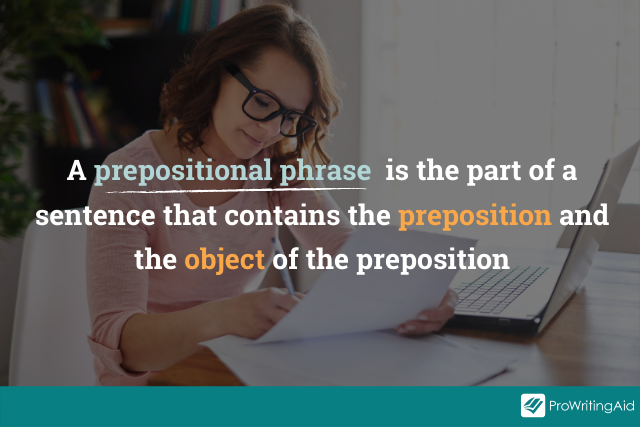
It’s an easy definition. A prepositional phrase is the part of a sentence that contains the preposition and the object of the preposition. The object is the noun or pronoun that follows the preposition. Remember, objects are always nouns or pronouns.
Let’s go back to the example from the very beginning of the article: “over the river, and through the woods, to grandmother’s house we go.”
This sentence in the nursery rhyme contains three prepositional phrases:
- Over the river
- Through the woods
- To grandmother’s house
Notice that our prepositional phrases do not include the words and, we, or go. They only include the prepositions—over, through, to—and the objects following them.

Here are some more examples of prepositional phrases:
- At home
- In the big, blue house
- To the store
- For God and glory
- By the way
- Of mice and men
How Do I Use Prepositions Correctly?
You have probably figured out that using prepositions isn’t always easy.
Often, native English speakers don’t even understand the rules. We just go by what sounds correct to our ears. Plus, certain prepositions can be used differently in different English-speaking countries.
It’s always a good idea to run your writing through a grammar checker like ProWritingAid’s Grammar Report. Be sure to pay attention to the English language settings to ensure you are getting the most accurate results for your audience.
With ProWritingAid, you can rest assured that your prepositions are correct.

One thing to be mindful of is your sentence structure.
A preposition is almost always followed by a noun or pronoun. There might be an article (a, an, the) before the noun, and you might see an adjective before the noun. But if you have a verb after your preposition before a noun or pronoun, you are not using the preposition correctly. A preposition will never precede a verb.
This may be confusing. There are lots of examples of what seem like verbs being used after prepositions:
- On doing this, she left the room.
- She stopped him from falling.
Doing and falling in these instances are actually gerunds. These words take the form of verbs but actually function as nouns.
A final note on verbs. Some verbs, like consider, influence, and emphasize don’t need prepositions before them.
- I will consider about this further.
Should actually be written as:
- I will consider this further.
Check out our examples of verbs that don’t need prepositions.
Can I End a Sentence with a Preposition?
You might have learned in school that you can’t end a sentence with a preposition. No one is quite sure why this rule ever existed. But you absolutely can end a sentence or clause with a preposition.
Often, when you try to rearrange your sentence without a preposition, it sounds stiff, awkward, and unnecessarily formal. Here’s an example:
- I have too much with which to deal.
vs.
- I have too much to deal with.
No one speaks like the first sentence. It’s much more natural to say or write the second sentence. They are both grammatically correct.
Always consider your audience when deciding whether to put a preposition at the end of a sentence. In formal writing, it is often better to place the preposition earlier in the sentence, like this:
- The archaeologists are unsure from where the stone tool originated.
- The archaeologists are unsure where the stone tool originated from.
The top sentence is better for a formal essay or report, although neither are incorrect.
Unnecessary prepositions at the ends of sentences should be eliminated, however. These bog down your writing with sticky words, making your message less clear and concise:
- I don’t know where the store is at.
- I don’t know where the store is.
In this case, “at” is unnecessary. It does not add any additional meaning to the sentence. When editing your writing, pay attention to the prepositions that end sentences to be sure they are necessary.
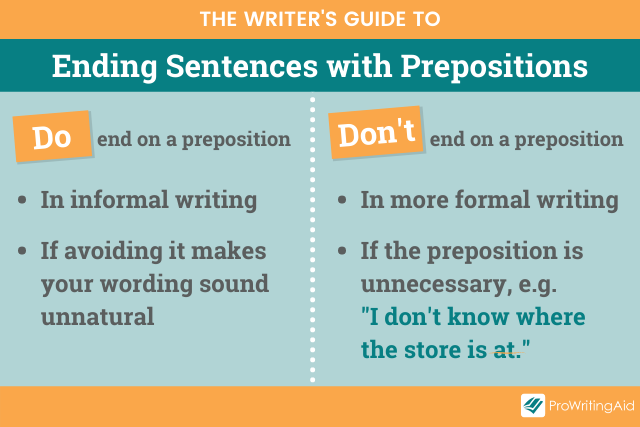
What Are the Functions of Prepositions?
In the simplest terms, prepositions show a relationship between a noun and other parts of a sentence. But prepositions commonly serve specific functions. They often refer to location, placement, orientation, or time. Here are some of the ways prepositions are used.
Using Tools
If you’re describing the use of an implement, machine, or device, you’ll need a preposition. For example:
- I traveled here by airplane.
- I wrote this article with a keyboard.
Directions
These prepositions indicate an object’s direction, or the way it’s facing.
- The shape lumbered towards me.
- The fly buzzed away from me.
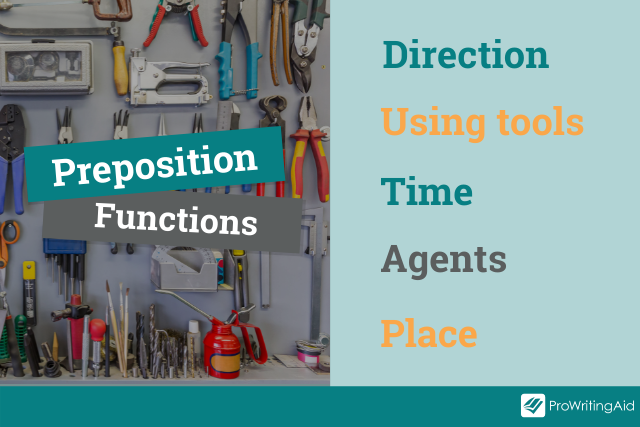
Time
Prepositions of time indicate how objects relate to one another in terms of when they happen.
- On Sunday, I usually watch football.
- I’ll call you when the game’s over.
- In 1965, The Who released their first album.
Agents
These prepositions correspond to a person or an agent performing an action.
- Some of my favorite books were written by Stephen King.
- I played fetch with my dog all day. Good dog!
Place
Prepositions of place define an object’s position.
- The cat is on the table again.
- I’ll meet you at Applebee’s.
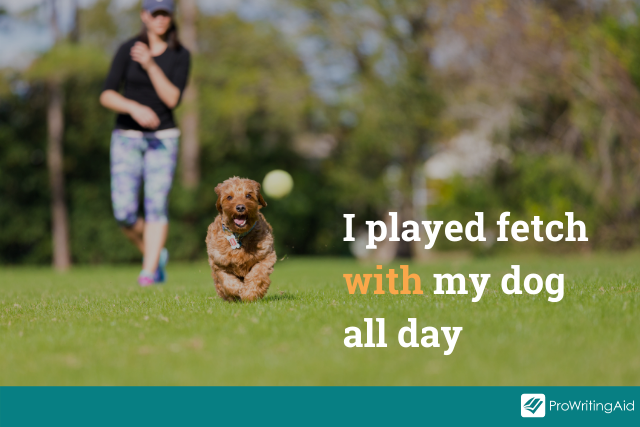
More Examples of Prepositions: Test Your Knowledge
The best way to learn prepositions is through copious examples. Can you identify the prepositions in each of these sentences? What about the prepositional phrases?
If you really want to quiz yourself, try to determine what type of preposition is being used.
- The puppy is beneath the table.
- I drove over the bridge.
- It’s nice to be among friends.
- He can’t do anything without his phone.
- Between you and me, she’s not very good at cooking.
- I’ll arrive by noon.
- We went from Paris to Bordeaux.
- Did he get into the master’s program at Oxford?
- There are monsters under the bed!
- He accepted the award on behalf of the cast.
- Her words came from deep within her heart.
- Place the hat atop the snowman’s head.
- I am shocked I met my deadline, considering the time I started.
Answers
- The puppy is beneath the table.
- I drove over the bridge.
- It’s nice to be among friends.
- He can’t do anything without his phone.
- Between you and me, she’s not very good at cooking.
- I’ll arrive by noon.
- We went from Paris to Bordeaux.
- Did he get into the master’s program at Oxford?
- There are monsters under the bed!
- He accepted the award on behalf of the cast.
- Her words came from deep within her heart.
- Place the hat atop the snowman’s head.
- I am shocked I met my deadline, considering the time I started.